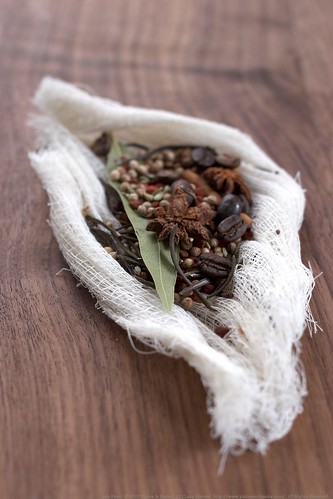A Sandwich Over a Year in the Making
It didn’t take me a year to assemble this sandwich. Or, for that matter, even to cook the corned beef from scratch, although that took considerably longer than I had expected. No, it’s been a year now that I’ve been promising to make Cam, or at least attempt to make Cam, a corned beef sandwich to rival those we have when we visit the east coast. The thing about Seattle, with all its amazingly fresh and seasonal cuisine, is that we still haven’t found a deli here that can serve it up like Katz’s can (although if you have any suggestions for us, we are all ears).
Initially, I put it off under the reasonable (yet pretty much wholly untrue) excuse that it would make a good post for March. At the time it was already April, so I bought myself plenty of time to figure out just how to make a corned beef brisket. The idea was daunting. I don’t cook a lot of meat. So, making a brisket, something I’ve never before cooked, and making it meet such high expectations, well, let’s just say it was easier not to think about it for a while, and just go to Roxy’s where they do make a pretty good pastrami. So, the months ticked off, and I stuck to my (lame) excuse that I’d make the corned beef in March. And then, March happened. Somewhere around the second week in March, I finally got around to looking up a recipe.
Now, I have my issues following recipes to a T… but as I started to find recipes for corned beef, I knew I was in trouble. First, there were significant deviations in the initial brining ingredients… most calling for some kind of icky nitrite type stuff that scares me. Salt peter? No thanks. Prague Powder #1? Yikes. And then, there were those recipes that didn’t even bother to list out the ingredients, but just called for brining spices or pickling spices. I’m not exactly sure where you find those… I checked with two different groceries with no results. Luckily, another quick web search turned up a couple of pickling spices recipes, and I was able to fudge my way from there, adding a few secret ingredients to round out the flavors. OK, one secret ingredient really. And, it’s not so secret, as I’m going to tell you. In addition to the usual anise, cinnamon, bay, juniper berries, peppercorns, coriander seeds, annatto and rosemary, I threw in a few coffee beans. Not many… just a few to add a little something extra.

Next, there were significant differences in how long to brine the brisket. Some called for only three to four days, others three to four weeks! As a corned beef newbie, how does one decide? I split the difference and brined my brisket for 10 days.
So, with brined meat in hand, I was ready to cook it up. Back to the recipe. Only to find that the recipe figures you already know what you are doing, and follows up the brining step with “cook as usual.” Huh? Um, if I knew how to cook it, I wouldn’t be looking at the recipe. I don’t just need brining instructions! I want to know how to make fall apart tender corned beef that I can stack to the ceiling on a sandwich. Moving on to a couple more recipes, I find one that is cooked in beer. That doesn’t exactly sound “usual” to me, but what the heck.
Four hours of simmering later, I pull out the meat just as Cam walks in. He’s been excited about the brisket for days, and I give him a little nibble. He’s impressed. Maybe not Katz’s deli impressed, but still better than most that you’d find in Seattle (at least according to him).
Then, he asks me that inevitable question, what are we having with it. I’ve been so focused on the beef (as well as a couple of shoots while the meat was cooking) that I really didn’t think about what we’d eat with our mouth-wateringly tender corned beef. How about bread and mustard?
Corned Beef Brisket for Sandwiches
makes enough for 4 to 5 sandwiches
Note: Because I’ve left out the nitrites, this corned beef isn’t the pink color you may be used to seeing, but instead it’s the fairly dull grey color that you’d expect from brined and boiled meat. I added the annatto seeds for color, but they didn’t have much impact. Still, I would much rather eat greyish meat than salt peter…
For brining
5 lb beef brisket
water
“Pickling Spices” – adjust to your heart’s content
1 bay leaf
a few star anise
1/2 cinnamon stick
1 t coriander seeds
1 t black peppercorns
1 t rosemary
1 t thyme
1/2 t annatto seeds
1/2 t orange or lemon zest
10 coffee beans
sea salt (lots – see method)
3 cloves of garlic
For cooking
1 bottle of lager or ale (nothing too fruity)
water
3 cloves of garlic
1/4 cup black peppercorns
1 bay leaf
Rinse the beef brisket and trim off any excess fat (but don’t trim off all the fat!). Set aside.
Combine the pickling spices and wrap them up in cheesecloth. Tie with a string and trim off any strings that might try to escape into the brine. Give it a good shake to make sure.

Place the brisket in a large pot, and cover it with water. Then, remove the brisket and refrigerate. Start adding salt to the water, on low heat, and stir till the salt dissolves. Keep integrating salt at about a 1/4 cup at a time until a fresh raw egg will float in the water. Then, add the pickling spice satchel and bring to a boil. Remove the satchel, and let the water cool to room temperature.
Then, place the meat in a gallon-sized plastic bag and fill with the remaining liquid. Carefully seal the bag, getting out as much air as you can. You want the brisket to be completely submerged in the brining liquid on all sides. You might want to double bag it, just in case. Place the bag in the refrigerator and let it sit for about a week to 10 days, flipping it over each day.
When it’s done brining, remove it from the refrigerator, and dump out all the brine liquid. Rinse the brisket, and place in a large pot with a cover. Add the beer and enough water to cover the the brisket by about an inch. Add the garlic, peppercorns and bay leaf. Bring to a boil, and then reduce to a simmer. Simmer for four to five hours, or until it reaches the desired tenderness. Make sure you check on it every 30 minutes or so, and add more water if necessary.
When it’s done, carefully remove it from the pot and onto a cutting board. It should be very tender, so take care how you lift it out of the pot. Then, slice against the grain in thin slices for sandwiches. Best served on a light rye bread, with a squiggle of mustard and maybe a bit of melted provolone.
Technorati Tags: Food, Photography, recipe
I love this kind of long-term, research-based project that’s also a work of love. How did you yourself like the final product?
Thanks Astrid! And, I thought it was delicious!
I agree..there’s nothing quite like a long planned project coming to fruition.. great idea to use coffee beans in the brining..
Oooooh…this looks fabulous! Corned beef is one of those things we can’t get here….this will be on my “to try” list! 🙂
What a project indeed! Persevering has definitely paid off in the great result. Looks very appetizing!
And as appetizing as it looks, it tasted even better! I’m really hoping we can add this to some regular rotation, since it totally sated my deli craving – which I’m sure will be back again soon!
Note – for the 1 gallon plastic bag she used a ziplock – which is probably obvious to all you foodies out there but I figured I would clarify:-)
I’m impressed; I love corned beef but only make it once a year, on St. Paddy’s Day, due to all the preservatives and such (see my post at http://technically.us/eat/articles/2007/03/15/mom-make-a-st-patricks-day-dinner ) but you have inspired me to corn my own brisket. Then we could eat it a lot more often.
Love your site, too!
We swear by the Cooks Illustrated version. I think it’s about a week in the brine. No nitrites or other hard-to-get ingredients, so it’s brown, not pink. But it’s delish anyway.
Hmm, interesting. I usually just buy that big bag of corned beef- it’s already brined and pinkish- that tells you to drop it in a pot of water or stock and cook xx time blah blah. I never considered brining it myself… but that looks so delicious. With some homemade rye bread, perhaps even more so? 😉
I’m being a bit lazy and just asking you even though I probably could browse for the answer (you seem like you’ve put a lot of work into this, though)…aside from all of the preservatives, does making corned beef this way make it much healthier? I’ve always heard quite negative things about corned beef, but never really understood what made it less desirable than all of the other deli meats. Would this corned beef be suited to a Reuben, or is it a bit more substantial than that, if that makes sense?
Hi Rachel – well, on the healthy front, I guess that depends on what you are trying to do. By making it yourself, you can reduce the fat some (although not too much, or it won’t be very good). But, it’s still brined meat, so it will be high in salt no matter how you slice it. Definitely the lack of nitrites is much better for you though.
It’s also definitely great for Reubans, as well as served with some cabbage/carrots/potatoes.
-L
Love your blog! Thanks for sharing your corned beef recipe. Just made some last night from an old family recipe but as we hadn’t made it in a few decades we were a little rusty. Was so happy to see your version and will try it next week! Would this be suited to corned beef hash do you think? Would I just shred the meat and saute with potatoes?
I HAVE AVOIDED NITRITES FOR MANY YEARS SO WAS DELIGHTED TO FIND THIS RECIPE. AS A SINGLE PERSON 5 POUNDS OF BRISKET IS TOO MUCH AT ONCE. CAN THE BRISKET BE FROZEN AND WOULD YOU DO THIS AFTER BRINING OR AFTER IT HAS BEEN FULLY COOKED? ANY IDEAS OUT THERE? CAN HARDLY WAIT TO TRY IT IN SANDWICHES AND HOMEMADE CORNED BEEF HASH!